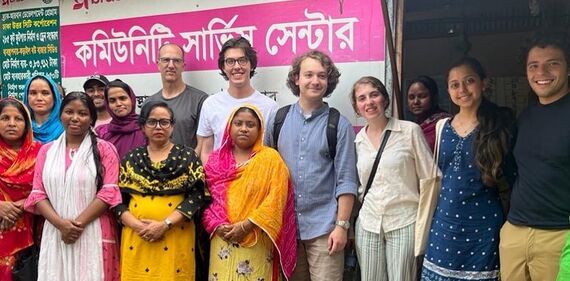
Reflection on Georgetown's Dhaka Trip
Paul Medvetsky is a senior in the School of Foreign Service and research assistant in the Georgetown Global Cities Initiative.
In the last week of May, I was part of a group of six students who went to Dhaka along with professor Tariq Omar Ali and Dean Mark Giordano. Over the next eight days, we met city officials and rickshaw pullers and everyone in between, exploring the city from multiple perspectives.
Dhaka, the vibrant capital of Bangladesh, stands as one of the most densely populated urban centers globally. Its population grows by over 2,000 people daily, with new buildings constantly entering the skyline and the streets always filled with people and vehicles. This growth simultaneously presents both opportunities and challenges for the city and nation. Dhaka is the center of Bangladesh’s economy, with growing infrastructure projects solidifying it as a key node in the globalized economy. However, its infrastructure struggles to keep up with the population growth, breeding other social and economic issues.
Our trip was informed and inspired by the course “DC/Dhaka,” which was ignited by Eve Bratman’s provocative question: Is Washington, DC a “third world” city? Bratman’s article called to attention the contradictions between Washington, DC’s position as a major center for international development initiatives and its “underdeveloped” areas with acute poverty and disinvestment. Through the course, we also questioned the framing of urban problems through a “development” lens by showing that cities are not mere conundrums awaiting developmental intervention.

Right from the first step I took outside of the airport, I was blown away by the variety of spaces and built forms throughout the city. 16th-century structures stood shoulder-to-shoulder with contemporary 21st-century counterparts, swiftly filling the city's skyline. Dhaka is a city layered with history like a palimpsest.
Much of our trip was spent focusing on discussing urban governance and development, inspired by our meetings with local professionals and officials. Our visits included: touring the Parliament building, meeting the North City Corporation Mayor, learning about urban challenges from BRAC and BRAC Institute of Governance and Development staff, and speaking with members of a women’s council in a major informal settlement named Karail. BRAC is the world’s largest NGO (by employees) and is involved in national and international development projects; BIGD is one of its research and urban governance arms.
In Dhaka, extreme wealth and extreme poverty seem to coexist spatially. We saw numerous examples of informal and unequal urban spaces, exemplified by sprawling marketplaces with nearly infinite stalls and constant activity. On the other hand, Gulshan and Banani, two of the most posh areas of the city, heavily rely on labor from Karail and other impoverished areas. Observing urban informality and inequality on site enabled us to think critically about urban history and development in Dhaka.

At times, we switched our focal point from the informal economy to Dhaka’s fascinating cultural worlds. We were deeply impressed by the visual art works showcased at Bangladesh University of Engineering and Technology, murals that adorned walls of the city, and decorations on the rickshaws. Inspired by the city’s cultural connection to water, we also ate hilsa, Bangladesh’s national fish, by the Padma river while also exploring recently-built infrastructure in the area. Dhaka’s cultural richness is also demonstrated through its religious diversity. We encountered mosques, a church, and a gurdwara. Our interaction with the local Baba, a distinctive figure in the South Asian Islamic practice, was another meaningful experience to experience Dhaka’s cultural mosaic.
Dhaka is a city of many worlds. Spatially, it accommodates both the working class and the elite, just as historic and modern buildings harmoniously coexist. Yet, Dhaka has more to offer than just the spatial manifestation of its wide wealth gap. Dhaka’s cultural vibrancy showed us the beauty of the city and people that a ‘development’ perspective may overlook. As students, future policymakers, and world citizens, we go back to Washington, DC with a set of new questions. What we learned from this trip was that we must study places from a holistic perspective. In all cities, there are lessons to be learned.

